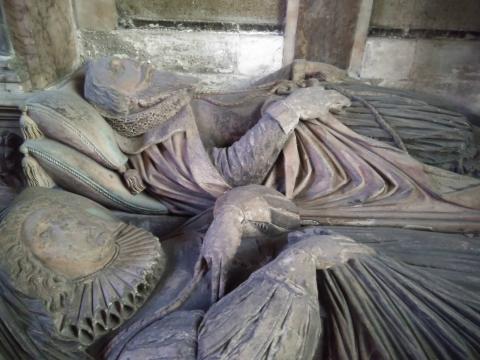James Ley Laid Low

While snooping about All Saints parish church at Westbury, Wilshire, while visiting my relations of that county, I came across a fine Jacobean tomb. It belonged to a Sir James and Lady Ley, who turned out to be more significant figures than the usual county squires one is used to finding entombed in provincial country churches. Ley was Chief Justice of Ireland, Lord High Treasurer of England and he rose to the rank of Baron and later of Earl of Marlborough, which is a steep rise. His memorial stone affixed to the grand tomb was erected by his son and is suitably effusive about the man’s achievements (the fulsome translation of which one may read at the bottom), and concludes:
So this great man, whose weighty judgement was moulded by nature and developed by learning, having faithfully filled public offices up to his declining years, in a ripe old age and in a peaceful death, gave back to God a spirit that had deserved most highly of his country, at Lincoln's Inn, London
The website of Parliament, however, which helpfully provides details of many of its former members, gives a more balanced assessment, for it has no reason to paper over his faults nor memorialise him. His initial baronetcy (an hereditary knighthood), he purchased rather earned. His tenure as Irish Chief Justice was characterised by a hardline policy of religious conformity, during which defendants were denied copies of the indictments against them, resulting in him being “generally behated throughout the kingdom.” Aged 70, he made an astute marriage to the 17-year-old niece of George Villiers, the royal favourite, to whom Ley owed his further advancement as Lord Treasurer in 1624, for which he still paid a staggering £15,000.
So was he that faithful old servant of the nation, selflessly living for the welfare of the state., or was he a grasping and shrewd politician, for ever keeping a beady eye on his and his family’s prospects of advancement? Probably both. If the Parliamentary historian and biographers can give a more balanced view of Ley’s achievements, how much more the great God who sees the heart? What others think of us, and much less, what we think of ourselves, will not be relevant at the Great Tribunal. God cannot be fooled, hoodwinked or persuaded, for He knows all. Only what Jesus Christ wrought at Calvary can make amends for burning ambition and formidable pride.

Sacred to God, the best and the greatest. Here in peace rest the bones and ashes of Sir James Ley, Knight and Baronet, sixth son of Henry Ley, of Teffont Evias, Esquire. As a young man he was engaged in the study of law and displayed such ability as to climb through all its stages to the highest summit of legal fame. He filled the post of Chief Justice of the King's Bench in Ireland: and being recalled to England became Royal Proctor of Wards in Chancery and subsequently Chief Justice of King's Bench: having won an honourable reputation in the discharge of these functions, King James honoured him with the title of Baron Ley of Ley (The ancient family seat in Devonshire), summoned him to the Privy Council, and appointed him Lord High Treasurer of England: and King Charles bestowed the further honour of the Earldom of Marlborough and instituted him President of the
King's Council. He married Mary, daughter of John Pettey Esquire, of Stock Talmage, Oxfordshire-her body is laid beside his - of whom he had numerous issue: Henry (now Earl of Marlborough) James, William, Elizabeth, Ann, Mary, Dionysia, Margaret, Hester, Martha, Phoebe. Upon the death of his wife he espoused Mary, widow of William Bowler, Knight; and after her decease he wedded Jane the daughter of Lord Butler, by neither of whom had he any children. So this great man, whose weighty judgement was moulded by nature and developed by learning, having faithfully filled public offices up to his declining years, in a ripe old age and in a peaceful death, gave back to God a spirit that had deserved most highly of his country, at Lincoln's Inn, London - a place above all dear to him- on the 14th day of March, in the year of our salvation, 1629.Henry, Earl of Marlborough, has with abundant tears, hallowed this monument as a last tribute to his most worthy parent.

- Log in to post comments


 Sunday Worship 10.45am & 6.00pm
Sunday Worship 10.45am & 6.00pm